Photo courtesy Andrew Zwarych / Philadelphia Union
Jeff Rueter and Sam Stjeskal of The Athletic published a piece last week, behind the paywall, discussing MLS’s tentative plan for resuming season in home markets.
While no announcement has come from MLS, we can work with this.
Reducing the body of Rueter and Stejskal’s work to only the huge bones, there will be three phases to the rest of Major League Soccer’s 2020 season.
Calendar basics
- Phase One: Sat., Aug. 22 – Sun., Sept. 13 22 days six games
- Phase Two: Weds., Sept. 16 – Sun., Nov. 8 53 days 12 games
- Postseason: Fri., Nov. 20 – Sat., Dec. 12 18 teams single elimination
On July 15, Steven Goff of The Washington Post wrote, “Without many spectators, MLS would not feel the need to schedule most matches on weekends. One person familiar with the plans said the league could end up holding games several days per week.”
Working to modify the randomness of that idea is the pace of play given above. During Phase One Monday – Friday, Tuesday – Saturday, or Wednesday – Sunday cycles seem de rigeur. Different groups — see below — could be distributed equally among the three possibilities.
Regional groups
A second probable schedule characteristic is the conferences being subdivided into regional groupings, especially during Phase One. During the first 22 days the three Canadian teams will play their six games among themselves north of the border. The multiplication tables strongly suggest each will play the others three times. Rueter and Stejskal report that after those three weeks, Toronto is already exploring playing its Phase Two “home” games in the United States.
One possible stateside regional grouping will be speculatively presented below, but it is based only on one man’s ideas of minimizing travel on a map and probable group sizes. There is no evidence supporting the scheme whatsoever. Phase One’s rapid game frequency does mitigate towards minimizing travel distance , and Phase Two’s average pace slows by lonely one day.
Here is my regional groupings guess, with the “minimize” in minimizing travel varying by as much as an order of magnitude. Note that only the Canadian group includes interconference play, another guiding principle The Athletic’s article mentioned.
Canada: Montreal, Toronto, Vancouver.
Northeast: New England, New York Red Bulls, New York City FC, Philadelphia.
Midwest: D. C., Columbus, Cincinnati, Chicago.
Dixie: Miami, Orlando, Atlanta, Nashville.
Texas: Kansas City, Dallas, Houston
Flat, or Not: Minnesota, Colorado, Salt Lake City
West Coast: Seattle, Portland, San Jose, Los Angeles Galaxy, Los Angeles FC
Any grouping scheme would destroy all equity in strengths of schedule, no matter the groups’ actual compositions. In the example above, look at the West Coast, a group of death even it does include the Galaxy.
Crossing the border
Less can be deduced about Phase Two, probably because of the Canada conundrum. If the Canadian government denies entry to MLS’s teams as it has to Major League Baseball’s, Montreal and Vancouver will have to find accommodation south of the border too.
The only counterargument to Canada’s decision-makers is MLS’s track record of keeping teams clean once they are within a protective bubble. For the past several weeks the league reports no new confirmed positive virus tests inside the complex at Disney.
Major League Baseball can make no such argument, as Monday’s reports of the Miami Marlins being stranded in Philadelphia because of four positive tests confirm. The Fish have had to cancel their home opener.
Playoffs
Another curiosity that Rueter and Stejskal report concerns the postseason. The usual progression of a tournament’s growth follows the exponents of two, from eight teams to 16, not 18. At a guess, MLS realizes it was lucky it had 26 original entrants into the MLS is Back event because two were diseased and had to withdraw. The extra two in the playoffs may be insurance, and can easily be absorbed by a play-in match between each conference’s eighth and ninth place finishers, should all 18 qualifiers begins the process healthy.
We now have some idea for what the Florida tournament — a preseason conditioning event whose games nonetheless count — has been preparing. There is good reason why Jim Curtin and Oscar Pareja held a “friendly” between their benches the day after their tie won Orlando Group A. Given the probable future, their “benchies” will need match fitness, too.
Rules concerning club activities between the tourney championship August 11 — or earlier if a club did not make the final — and the beginning of home market play August 22 are unknown.
Parenthetical remark
Should the league’s teams end their regular season having played unequal numbers of games, they could be ranking in the table by using the average points per game statistic, total points won divided by total games played. That is how the now-defunct U.S. Soccer Development Academy leagues handled the differences between those sides who could and could not continuing playing in winter.


btw Has anyone heard where NYPigeonsFC will be playing their ‘home’ games?
.
It’s not going to be Yankee Stadium – they’ve been officially kicked out of there for this season. (Please, please, please say PinkCow Arena!!!)
At halftime of one of the games Tuesday night (?) the ESPN commentator group interviewed the NYC FC coach, Ronny Deila (sp?).
.
The coach was asked that very question and he had no answer of substance, he presented as not knowing. He did mention Red Bulls Arena as a possibility.
i heard energy drink as well. it’s a beautiful thing.
Seriously? Dixie?
Are you that tone deaf?